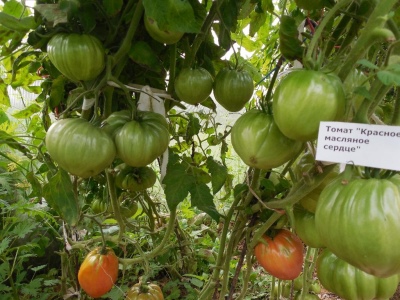
- Authors: USA
- Name synonyms: Red Butter Heart
- Category: grade
- Growth type: indeterminate
- Appointment: fresh consumption, for juice
- Ripening period: mid-season
- Growing conditions: for greenhouses
- Transportability: No
- Bush size: tall
- Bush height, cm: 180-200
The red oily heart belongs to the American varieties. The variety with giant fruits is perfectly adapted for the middle zone of our country. Here it is grown in shelters, using it to the full for the production of juices and pasta.
Description of the variety
Due to the indeterminate type of growth, the bushes of the Red Oil Heart are very tall, reaching up to 200 centimeters. The roots are tapy, strong, so there are usually no problems with getting food from the soil. The foliage is not unusual: thin and narrow, dark green in color.
The main qualities of the fruit
Large berries of the Red Oily Heart are capable of reaching a mass of 500-800 grams. The largest tomatoes grow to a weight of 1500 grams, and this is an amazing result for this crop. Red fruits fully live up to their name, having a heart-shaped shape. They look especially like a heart if you cut a tomato into 2 halves.
It is worth noting that due to the large-fruited tomatoes, it is impractical to count on good keeping quality. The fruits quickly crumple and lose their shape, they cannot be stored for a long time.
Taste characteristics
The taste of the Red Oily Heart is excellent. These are very aromatic sweet tomatoes that are great both fresh and harvested. The pulp is characterized by fleshiness and oiliness.
Ripening and fruiting
From the appearance of the first sprouts to the full ripeness of the tomatoes, 100-110 days pass. Mid-season berries in most regions are ready for harvest in July.
Yield
The red buttery heart is characterized as a high-yielding variety. The bush gives 5 kg of fruit, and a square meter - 15. In vegetable gardens, the figures are slightly lower - 12 kg.
The timing of planting seedlings and planting in the ground
The variety in question begins to be sown for seedlings in the last days of February, but if necessary, you can shift the dates to the first days of March. Seeds are prepared for planting using classical methods: germination test, disinfection, growth stimulation. Grow boxes and soil are disinfected. The depth of the seeds is 1 cm. Sprayers are used for irrigation. The temperature in the building cannot drop below +25 degrees.
After picking, each sprout receives a separate container. During this period, you can already start feeding with minerals and organics. Shortly before disembarkation, they begin hardening procedures, constantly increasing the duration of the seedlings' exposure to the air. In late April or early May, grown samples are rooted in the greenhouse. In southern regions, where spring comes early, tomatoes are easily cultivated outdoors. It must be remembered that when landing in open ground, the ground must be warm. If cold weather comes, the seedlings will die.

Growing tomato seedlings is an extremely important process, because it largely depends on whether the gardener will be able to harvest at all. All aspects must be taken into account, from seedbed preparation to planting in the ground.
Landing scheme
The red oily heart forms shrubs that should receive maximum nutrition and light. For this reason, it is highly discouraged to thicken the planting. Three plants are enough for a square meter. Make sure that the bushes are at a sufficient distance from each other. The minimum distance is 0.5 meters.

Growing and care
Tomatoes of the described variety require complex care and adherence to several rules.
Tomatoes branch rapidly, and a large number of stems cannot be allowed. Excessive thickening can cause fungus. Shoots must be removed in a timely manner, ensuring that 2-3 of the strongest remain. All removal procedures are carried out in the absence of sunlight. The resulting wounds are disinfected without fail.
Pinching the top will also be an important point. Indeterminate varieties are ready to grow as high as you like, but growth must be limited, otherwise the plant will not have the strength to form berries.
The red buttery heart is in dire need of a garter. Without it, the bushes will fall to the ground under their own weight. They begin to tie up as the fruits form. Pegs and trellises will serve as supports. Any supports are installed during planting.
Watering many gardeners do drip. In this way, uniform irrigation can be achieved. If you are used to watering yourself, then you need to do this no more than once every 7 days. Watering the newly planted seedlings begins on the 7th or 10th day.
All plants need enough oxygen, and Red Oily Heart is no exception. In order for the tomato to get enough air, the topsoil must be loosened. Weed harvesting will be no less important. It is recommended to use organic materials for mulching.
Top dressing can be both root and foliar. Nitrogen substances are required only at the very beginning, then minerals and organics should be added. Top dressing is served by alternation.
Tomatoes Red buttery heart are distinguished by a long fruiting period. If the tomato is ripe, it must be immediately removed from the bush. Thanks to this simple rule, fruiting can be extended until autumn. Unripe specimens are laid out at home in a dry place. So they quickly reach ripeness.




A plant needs different micronutrients at each stage of growth. All fertilizers can be divided into two groups: mineral and organic. Folk remedies are often used: iodine, yeast, bird droppings, eggshells.
It is important to observe the rate and period of feeding. This also applies to folk remedies and organic fertilizers.



























































































